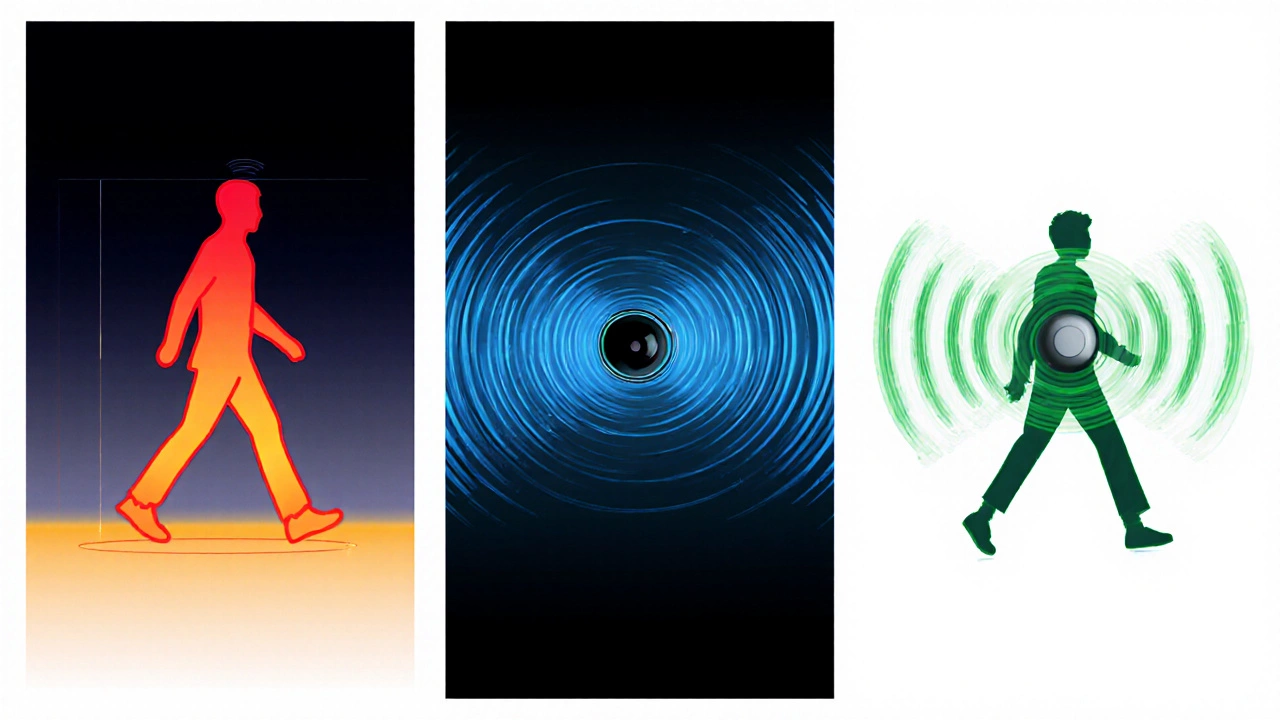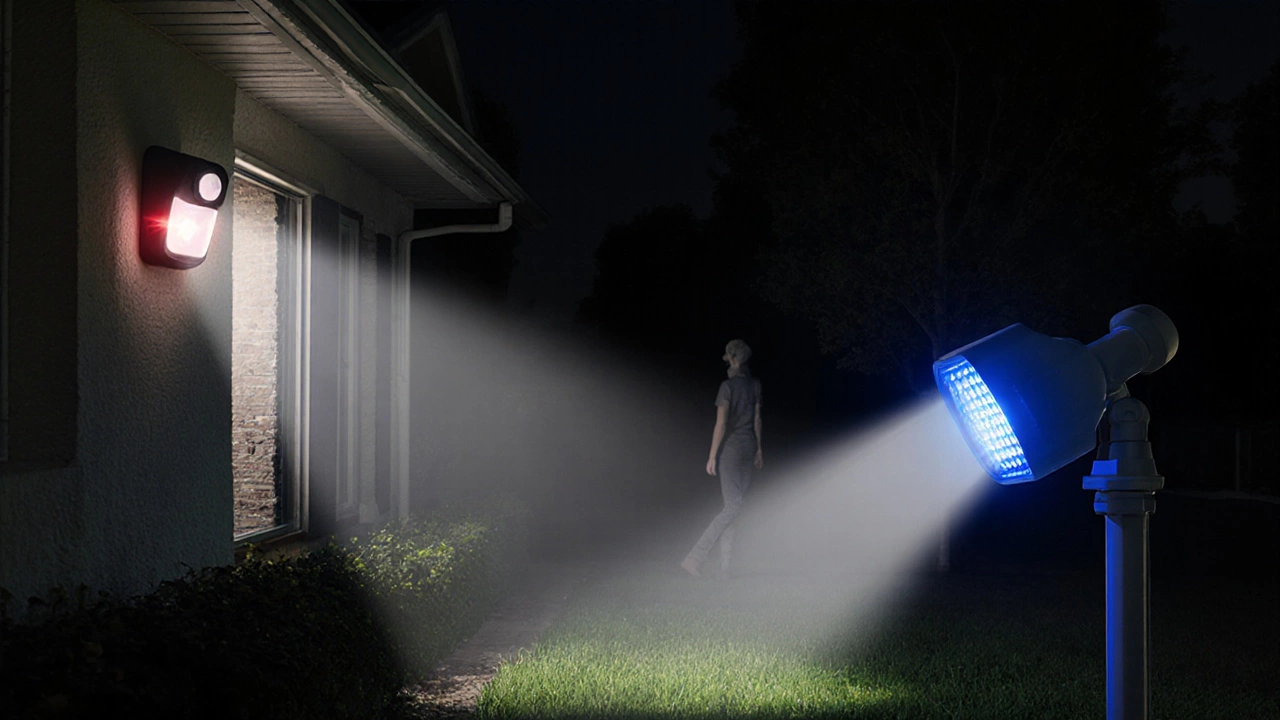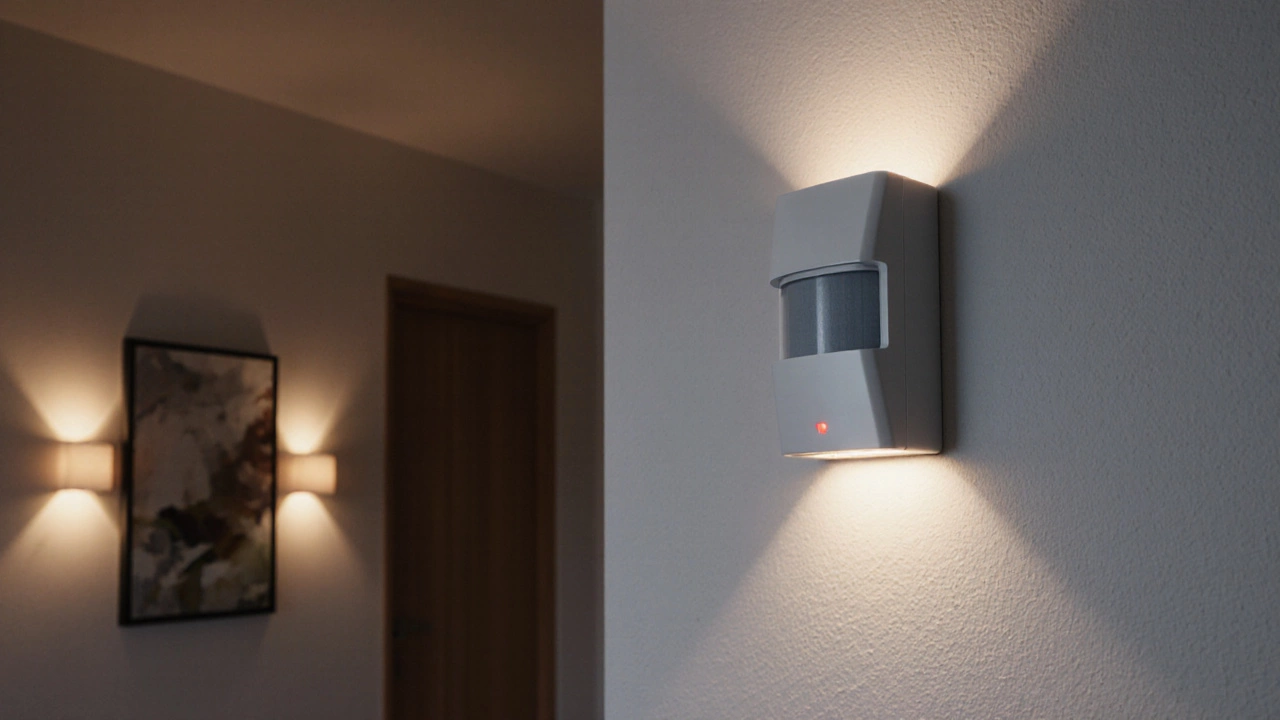Motion Sensor Selector
Recommended Sensor Type
PIR Sensor
Heat Detection
Low power, good for indoor spaces without pets
Microwave Sensor
Radio Wave Detection
Longer range, good for large areas and outdoor use
Ultrasonic Sensor
Sound Wave Detection
Unaffected by light, good for industrial settings
Sensor Comparison Table
| Attribute | PIR | Microwave | Ultrasonic |
|---|---|---|---|
| Energy source | Passive (detects heat) | Active (emits radio waves) | Active (emits sound waves) |
| Typical range | 20-30 ft | 30-50 ft | 10-25 ft |
| Field of view | 90°-110° | 120°-180° | ~360° (spherical) |
| Power consumption | Low | Medium-High | Medium |
| Common false-alarm triggers | Sunlight, heating vents | Moving trees, pets, fans | Loud noises, soft absorbers |
| Cost (USD) | $10-$30 | $25-$60 | $20-$45 |
When it comes to protecting a house or office, knowing motion sensors is the first step toward a reliable alarm system. These tiny devices sit in corners, on walls, or hidden in ceilings, and they watch for any movement that could indicate an intruder. But not all motion sensors work the same way - three core technologies dominate the market, and each has its own strengths, weaknesses, and ideal use‑cases.
Key Takeaways
- PIR sensors detect heat changes and are perfect for indoor rooms with minimal false alarms.
- Microwave sensors emit radio waves, covering larger areas but can be prone to interference from moving objects like pets.
- Ultrasonic sensors use sound waves; they excel in environments where light or heat detection is unreliable.
- Choosing the right sensor depends on room size, typical activity, and how you integrate it with a broader security or smart‑home system.
What Is a Motion Sensor?
Motion sensor is a device that detects physical movement within a predefined area and converts that data into an electrical signal that can trigger an alarm, notification, or automation. In modern homes, motion sensors are often linked to alarm panels, smart‑home hubs, or video cameras, creating a layered defense that reacts instantly when something moves where it shouldn’t.

The Three Main Types of Motion Sensors
Passive Infrared (PIR) Sensor
Passive Infrared (PIR) sensor detects changes in infrared radiation emitted by warm bodies. Human bodies constantly emit heat, and when a person walks across the sensor’s field of view, the infrared pattern shifts, prompting the sensor to fire.
- Detection range: Typically 20‑30feet horizontally and a 90‑degree field of view.
- Best for: Indoor rooms, hallways, and areas where pets are not a concern.
- Advantages: Low power consumption, inexpensive, and very low false‑alarm rate caused by sunlight or shadows.
- Limitations: Cannot detect motion through glass, and performance drops in extremely hot environments where ambient temperature matches body heat.
Microwave (Active Radar) Sensor
Microwave sensor emits low‑power radio waves and measures the Doppler shift caused by moving objects. When an object moves, it reflects the microwave signal back at a slightly different frequency, and the sensor interprets that shift as motion.
- Detection range: Up to 50feet, with a 120‑degree coverage angle.
- Best for: Large open spaces, garages, or outdoor perimeters where infrared might be blocked by foliage.
- Advantages: Can see through thin walls, glass, and even certain types of clothing, making it harder for an intruder to avoid detection.
- Limitations: More susceptible to false alarms from moving trees, fans, or pets; higher power draw compared to PIR.
Ultrasonic Sensor
Ultrasonic sensor produces high‑frequency sound waves and listens for the echo that returns after bouncing off objects. The time it takes for the echo to return tells the sensor whether something has moved into its detection zone.
- Detection range: Usually 10‑25feet, with a near‑spherical coverage pattern.
- Best for: Environments where temperature or radio‑frequency interference is high, such as industrial settings or rooms with many heat sources.
- Advantages: Unaffected by light conditions, can detect motion through thin fabrics, and works well in cluttered spaces.
- Limitations: Sound can be absorbed by soft materials, and loud background noise may reduce accuracy.
Side‑by‑Side Comparison
| Attribute | PIR | Microwave | Ultrasonic |
|---|---|---|---|
| Energy source | Passive (detects heat) | Active (emits radio waves) | Active (emits sound waves) |
| Typical range | 20‑30ft | 30‑50ft | 10‑25ft |
| Field of view | 90°‑110° | 120°‑180° | ~360° (spherical) |
| Power consumption | Low | Medium‑High | Medium |
| Common false‑alarm triggers | Sunlight, heating vents | Moving trees, pets, fans | Loud noises, soft absorbers |
| Cost (USD) | $10‑$30 | $25‑$60 | $20‑$45 |
How to Pick the Right Sensor for Your Home
- Assess the area size. Large open spaces benefit from microwave sensors; small rooms work fine with PIR.
- Consider pet ownership. If you have cats or dogs that roam freely, PIR or ultrasonic (with pet‑immunity settings) usually give fewer false alarms.
- Check for obstacles. Glass doors or large metal objects can block infrared but not microwave; choose accordingly.
- Think about power. Battery‑powered systems love low‑draw PIR units, while wired installations can handle microwave or ultrasonic models.
- Plan for integration. Many modern systems let you link sensors to smart home hubs. Ensure the sensor you pick offers the right protocol (Zigbee, Z‑Wave, Wi‑Fi, or proprietary).

Installation Tips & Common Pitfalls
Even the best sensor won't protect you if it's mounted wrong. Follow these practical steps:
- Height matters. Position PIR sensors about 6‑8feet high to capture torso movement while avoiding direct sunlight.
- Avoid corners. Both microwave and ultrasonic units need a clear line of sight; mounting them too close to walls reduces effective coverage.
- Test before you lock. Use the sensor’s test button or a smartphone app to walk through the detection zone and confirm reliable triggering.
- Mind the environment. Humidity can dampen ultrasonic waves, while RF‑busy neighborhoods may interfere with microwave signals.
- Configure pet immunity. Many newer models let you set a “pet delay” of 5‑20seconds, preventing short‑range animal movements from setting off alarms.
Connecting Motion Sensors to a Broader Security System
Today’s home security system is more than a siren; it’s a network of devices that can send push notifications, trigger lights, or start video recordings. Here’s a quick flow:
- The motion sensor detects movement and sends a signal to the central alarm panel.
- The panel checks whether the system is armed. If armed, it relays the alert to your smartphone via the cloud.
- Simultaneously, a connected security camera begins recording the zone.
- If you have a smart‑light hub, the motion event can turn on exterior floodlights to deter the intruder.
Most manufacturers provide a mobile app where you can fine‑tune these actions, creating a customized response that matches your lifestyle.
Frequently Asked Questions
Can a motion sensor detect stationary intruders?
No. All three core technologies rely on movement-heat shift, Doppler change, or echo variation. If a person stays completely still, the sensor won’t trigger. That’s why many systems combine motion detection with door/window contacts for comprehensive coverage.
Are microwave sensors safe for pets?
Microwave sensors emit low‑power radio waves, similar to Wi‑Fi. They’re generally safe for animals, but they can mistake a running dog for an intruder. Look for models with a pet‑immunity setting or combine them with PIR to reduce false alarms.
Do ultrasonic sensors work outdoors?
They can, but outdoor conditions like wind, rain, and ambient noise degrade performance. For exterior perimeters, microwave or dual‑technology sensors are usually a better choice.
What’s the difference between a PIR sensor and a dual‑technology sensor?
A dual‑technology sensor combines two detection methods-most often PIR and microwave-in a single housing. Both mechanisms must agree before the sensor fires, dramatically lowering false alarms while keeping the advantages of each technology.
Can I use motion sensors with battery‑powered cameras?
Yes. Many battery‑operated cameras have built‑in PIR sensors that wake the unit only when motion is detected, extending battery life to months on a single charge.

